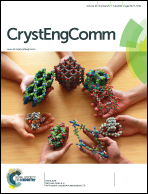Tuning the formation of dicarboxylate linker-assisted supramolecular 1D chains and squares of Ni(ii) using coordination and hydrogen bonds†
Abstract
Based on the variation in the multitopic dicarboxylates differing in the aliphatic chain structure (triple bond to double bond to single bond, respectively) in the formation of diverse coordination architectures for the same metal center and the ancillary ligand bpta, three new metal organic coordination networks (MOCNs) [Ni(bpta)(adc)(H2O)2]·2H2O (2), [Ni4(bpta)4(fumarate)4(H2O)4]·4H2O (3) and [Ni(bpta)(succinate)(H2O)2]·3H2O (4) are reported here (where bpta = N,N′-bis(2-pyridylmethyl)-tert-butylamine and adc = acetylene dicarboxylate). These are synthesized in good yields from a one-pot self-assembly reaction using Ni(OAc)2, bpta and the corresponding acid in methanol at ambient conditions. In order to shed light into their formation, the intermediate compound [Ni(bpta)(OAc)2(H2O)]·H2O (1) from the two-component mixture (Ni(OAc)2 and bpta), for all MOCNs has also been isolated and crystallographically characterized. Through strong hydrogen bonding between coordinated water, uncoordinated oxygen atoms of the two acetate groups and the lattice water molecule, 1 has a 1D chain structure. In 2 and 4, only one end of the dicarboxylate is coordinated to Ni(II) due to the fact that its other end (a carboxylate group not a carboxylic acid group which is commonly found for numerous polycarboxylic acids under hydrothermal conditions) is strongly hydrogen bonded to two coordinated water molecules of the adjacent Ni(II) center of the monomeric unit generating a 1D chain which is further hydrogen bonded through the lattice water molecules to form the respective 2D supramolecular assemblies. On the other hand, bis(monodentate) syn–syn and syn–anti bridging modes of fumarates between two Ni(II) centers result in the formation of a square in 3. These squares in 3 are further associated via hydrogen bonding through the formation of a six membered hexagonal motif R64(6) between two lattice water molecules, uncoordinated oxygen atoms of the fumarate and two coordinated water molecules on Ni(II) centers. The strengths of hydrogen bonding observed in the networks of 2–4 (the range of O–O distances is 2.638 Å to 2.949 Å) are very similar to those found in water and ice. All these are characterized by elemental analysis, single crystal X-ray diffraction, IR and Raman spectroscopy. Their thermal behavior in the solid state analyzed by thermogravimetric analysis (TGA) shows unusual stability of 3 up to 300 °C as compared to 2 and 4.


 Please wait while we load your content...
Please wait while we load your content...